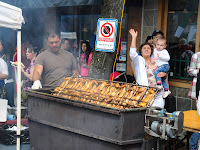It's quite amazing how your appreciation for a region undergoes a complete overhaul after you've visited it for a first time. Prior to getting started on this post, I took a look at the blogs topic bar and I saw that I've referred to McLaren Vale at least 16 times since I started identifying it as a separate topic, worthy of mention. It's a pretty basic truth to say that I had no real sense of place while drinking any of those bottles before Boo and I enjoyed our quick visit to South of Adelaide district in April.
 1183. 2005 Pertaringa Undercover Shiraz (McLaren Vale - Australia)
1183. 2005 Pertaringa Undercover Shiraz (McLaren Vale - Australia)
I must have picked up this bottle - for whatever reason - long before we'd ever set foot in the classic Aussie wine region, but I sure have a better feel for the wine now than I ever would have when I picked it up. Even though we didn't get an opportunity to stop in at the Pertaringa winery during our couple of days in McLaren Vale, there's no taking a sip of wine without having some mental picture of a general feeling for the area now.
The wine was an easy drinking drop and it featured a healthy does of big fruit, in that true Aussie; yet it wasn't over the top in any sense. Indeed, that was an overall feel of our's for McLaren Vale. The vineyards have little or no problem ripening the grapes; however, the region experiences a more calming influence of breezes coming off the nearby ocean waters and the resulting wines tend to be not as rich as some of the Barossans that make it to the North American market. Pertaringa, itself, is located in the Eastern foothills of the Vale which tend to be even a bit cooler weather-wise still.
Pertaringa has been around since 1980 and it produces around 10,000 cases annually. The winery has chosen an assortment of interesting names for its wine - drawing from local stories. The "Undercover" name comes from the winery's "recognition of McLaren Vale's history of supplying other regions with our finest red grapes." The fruit was regarded for its contribution to the mid-palate - yet, no one really knew that they were drinking wines that featured McLaren Vale grapes.
No worries about that now - particularly in our home.
Pertaringa has been around since 1980 and it produces around 10,000 cases annually. The winery has chosen an assortment of interesting names for its wine - drawing from local stories. The "Undercover" name comes from the winery's "recognition of McLaren Vale's history of supplying other regions with our finest red grapes." The fruit was regarded for its contribution to the mid-palate - yet, no one really knew that they were drinking wines that featured McLaren Vale grapes.
No worries about that now - particularly in our home.

























































